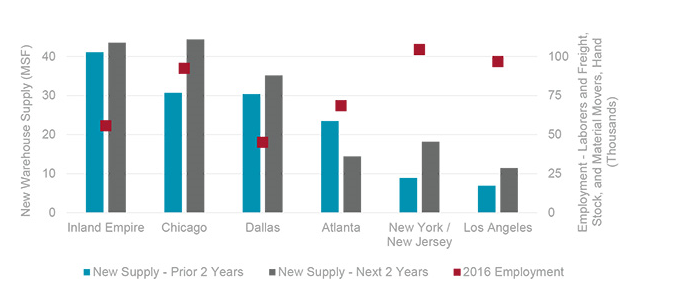Industrial Market Growing Strong
As of Q1 2017, online sales make up 8.5% of total U.S. retail sales, which is twice the proportion it was in Q1 2010. Factoring out the sale of items not normally purchased online such as fuel, automobiles and sales in bars and restaurants, eCommerce accounts for 11.7% of retail sales. With the growth in eCommerce, the supply of and demand for industrial warehouse space has been growing rapidly. In the three years ending in 2016, the supply of industrial product increased by 550.3 million square feet (MSF), which was well below the growth in demand (i.e., net absorption) over that same time (825.5 MSF). Increases in industrial space have driven growing demand for employees to operate warehouse distribution centers. In the past twelve months ending in June 2017, the Bureau of Labor Statistics (BLS) estimates that Transportation and Warehousing employment grew by nearly 97,200 jobs, which represents an increase of 2.0%. |
More People Needed to Move More Boxes
Laborers in Demand at Relatively Low Wages
As job growth has taken place, wages have also started to accelerate. For the past five quarters, the BLS’s employee cost index (ECI) has increased at a faster pace for transportation and material moving occupations than has the ECI for all civilian workers. In fact, the transportation and material moving ECI had its largest quarterly increase of the century in Q1 2017. Despite these increases, the most common position – manual / hand laborers moving freight, stock, and other materials (2.6 MM employees in 2016) – has one of the lowest wages among the various transportation and material moving occupations. In 2016 the median hourly wage was $12.49. |
5.1
million transportation and warehousing employees across the U.S.
|
Jobs and Space on the Rise in Large Industrial Markets
The markets with the greatest number of manual freight and stock movers include Gateway markets such as New York (104,400), Los Angeles (96,720), and Chicago (92,360), as well as the major industrial markets of Atlanta (68,510), Inland Empire (55,660), and Dallas (45,020). The location of these workers growth tracks closely with past and future industrial warehouse inventory growth. Over the past two years, warehouse inventory in these six markets has increased by 141.5 MSF. |
$12.49
median hourly wage for workers moving freight, stock or other materials manually / by hand.
|
| Cushman & Wakefield forecasts the introduction of new supply will accelerate in five of the markets with another 167.1 MSF being added by the end of 2018: Chicago (44.4 MSF), Inland Empire (43.5 MSF), Dallas (35.2 MSF), New Jersey (18.2 MSF), Atlanta (14.4 MSF), and Los Angeles (11.5 MSF). The influx of new supply will soften industrial vacancy rates in four of the aforementioned markets, creating potential opportunity in 2018 for occupiers looking for warehouse space. However, vacancy rates in Los Angeles and New Jersey are expected to remain steady even with the increase in new warehouse supply. |
167
million square feet of new warehouse space to be added in six market (BY END OF 2018).
|
|
Labor Supply a Growing Driver of Industrial Location
The relationship between labor supply and location is only growing more important. “As headcounts in today’s modern fulfillment centers rise, labor considerations are increasingly prioritized above real estate cost and attributes in decision-making, and sometimes trump distribution costs and service drivers. These trends favor labor markets offering better-suited demographic profiles and low to modest competitive demand to facilitate staff ramp-up and labor sustainability,” according to Keith Gendreau, Director of Strategic Consulting in Cushman & Wakefield’s Logistics & Industrial Service Line.
Warehouse Space Growth & Manual Movers Employment
|



Comments are closed